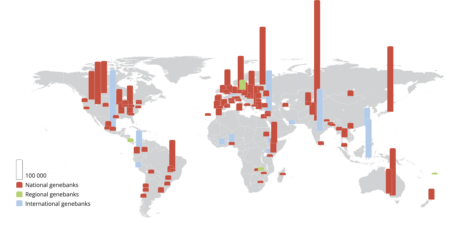I seem to be doing little more these days that quoting Jeremy’s latest Eat This Newsletter. I was actually going to include the paper Adoption of improved crop varieties limited biodiversity losses, terrestrial carbon emissions, and cropland expansion in the tropics in a forthcoming Brainfood — and I may still do so, if I can think of a pithy way to summarize its import in a sentence. But in the meantime, luxuriate in Jeremy’s more expansive prose.
Improved Crop Varieties: Good in Parts
A paper in the Proceedings of the National Academy of Sciences makes a strong case that, quite apart from producing more food, improved crop varieties have been A Good Thing. Using a new and more detailed model of global agriculture, researchers at Purdue University and USDA asked how improved crop varieties contributed to changes in land use, greenhouse gas emissions, and biodiversity loss from 1961 to 2015.
“From 1961 to 2015, global crop output was higher by 226 million metric tons.” Is that a lot? Hard to know. I looked at quantity of cereals produced, as recorded by the FAO, and between 1961 and 2015 the “developing” world average (i.e. excluding North America, Europe, and Australia and New Zealand) is only 26 million tons a year, a total of about 56 billion tons over the period. So 226 million tons is about 0.4%. I’m sure I have something wrong.
“World cropland use was lower by 16.03 million hectares.” Total world cropland is of the order of 1.8 billion hectares, so about 0.9% less cropland used globally, thanks to improved crop varieties. Again, must be a mistake. Still, reduced conversion of other land to agriculture means less habitat loss and, perhaps, fewer extinctions.
“[A]round 1,043 threatened animal and plant species … globally were saved due to slower cropland expansion.” This is very tricky because we just don’t know how many plants and animals actually went extinct between 1961 and 2015; known unknowns and all that. Certainly a couple of thousand, so this may be a tenuous win.
“In total, global [land use change] emissions under the historical baseline are lower by 5.35 … billion metric tons of CO2 equivalent.” The IPCC estimates about 150–200 tons CO2 equivalent per hectare of deforestation, and FAO estimates about 500 million ha of deforestation from 1961 to 2015, for a total of 75–100 billion tons CO2 equivalent. As much as a 7.1% decrease in emissions thanks to reduced land coming into agriculture.
As you might have guessed, I’m not actually that impressed. Of course improved varieties have been really important in actually feeding people, and famine deaths as a result of crop failure are around a tenth of what they were in 1961. Good nutrition, however, remains out of reach for many, many people even in areas that have seen productivity increase hugely thanks to improved varieties.
A thousand or so plants and animals may have escaped extinction, but how many important farmer landraces are no longer available as a result of the spread of improved varieties?
I realise it is churlish to complain about the things the study didn’t look at, and I am happy to acknowledge that they are aware of the deficits:
“[O]ur study does not take into account the full set of environmental and health consequences that may accompany crop intensification resulting from adoption of improved crop varieties.”
Indeed. My conclusion, for what it is worth, is that while improved crop varieties have made a huge difference to people’s lives, it’s a bit of a stretch to claim, as one report did, that Crop innovation has delivered more food, land, & biodiversity without at least considering some of those other consequences. Still, read that rather than the paper if you just want unalloyed good news.
